Chinese Steamed Buns with Scallions (Hua Juan)
This post may contain affiliate links. Please read my disclosure policy.
These homemade Chinese steamed buns with scallions emerge from the steamer puffed and bouncy, feathery light in texture with a nice chew and an onion-y flavor permeating every bite. Hua Juan are mainstays of Chinese breakfasts and snacks, fluffy white vehicles to be eaten on their own or stuffed with countless fillings from barbecued pork to egg custard. This recipe is surprisingly simple to make and so, so delicious.

Shortly after opening Cynthia McTernan’s A Common Table, I found myself reading about Chinese steamed buns, mainstays of the country’s breakfasts and snacks, fluffy white vehicles to be eaten on their own or stuffed with countless fillings from barbecued pork to egg custard.
The recipe looked simple and surprisingly familiar, not unlike making a brioche roll: knead together a slightly sweet yeasted dough, let it rise, punch it down, divide, shape, and … steam! Unlike a brioche bun, steamed buns are, well, steamed.
Lured by a photo of spiraled knots, I made the scallion buns, which emerged from the steamer puffed and bouncy, feathery light in texture with a nice chew and an onion-y flavor permeating every bite. My family, or, I should say, Ben, me and two of the four children (50%, hey, I’ll take it) gobbled them up. I served them with okonomiyaki, a favorite, and a soy dipping sauce, which we used for both the buns and the cabbage pancakes.
I haven’t had a steamed bun quite so good since many years ago now, when I found myself in San Francisco trying to get into the Slanted Door for lunch. Deterred by the hour-long wait, I headed instead to Out the Door, the Slanted Door’s takeaway outfit, and before long found myself, pork bun in hand, strolling the streets just as happy as ever.
I still dream about that bun: the warm, springy bread; the sweet barbecued pork nestled inside. It was perfect. Never would I imagine being able to make something even remotely similar at home. With this new knowledge of steamed-bun making in hand, I feel confident that pork bun of my dreams is closer to becoming a reality. As always, I’ll keep you posted.
Friends, I’ve been a long-time follower of Cynthia’s blog, Two Red Bowls, and her book, A Common Table, is a beautiful extension of that space, a mix of stories and recipes inspired by both her and her husband’s cultural and geographical roots. Read more about A Common Table on Cynthia’s lovely blog.
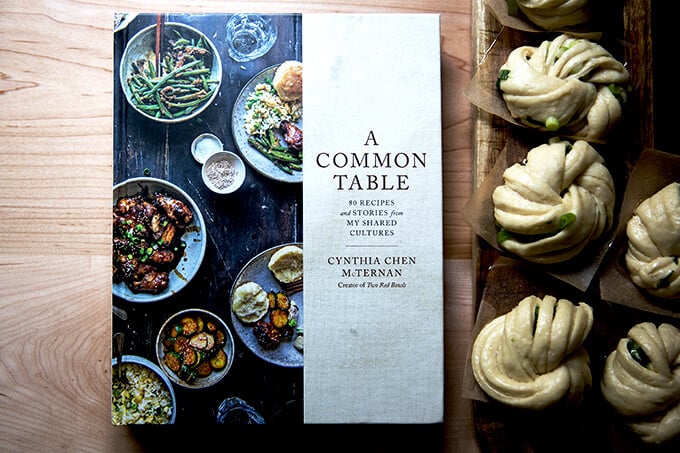
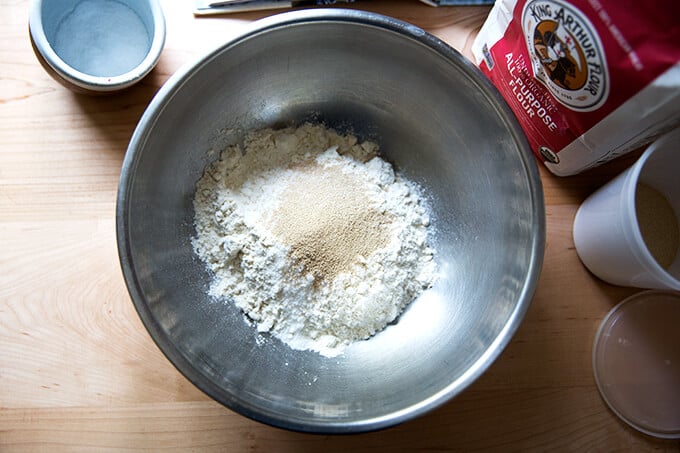
Here’s a steamed-bun-making play-by-play: Whisk together flour, sugar, salt, and yeast.
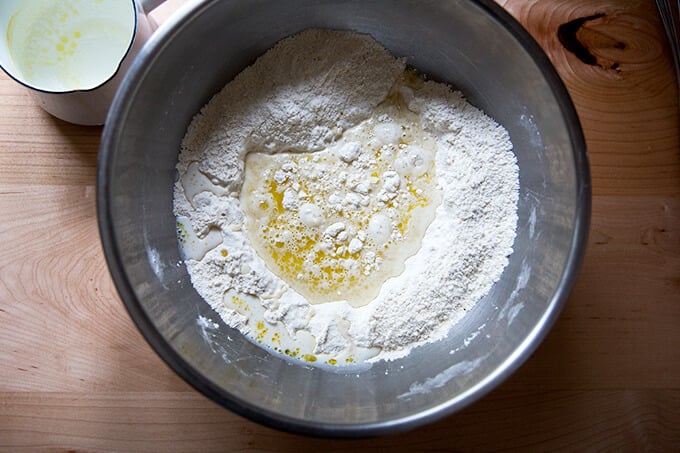
Add warm milk and oil.
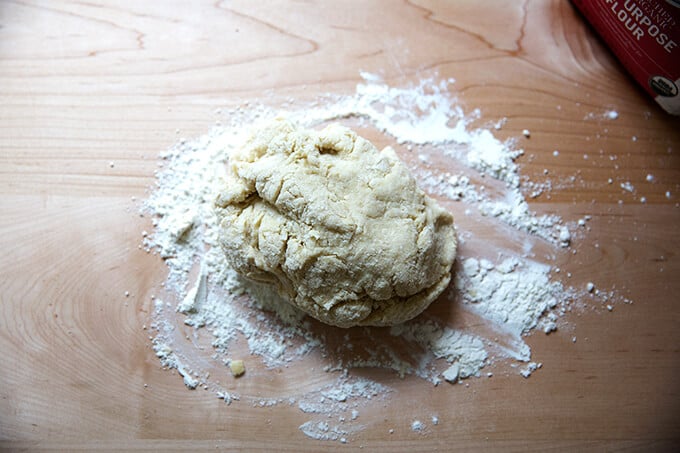
Form into a dough ball.
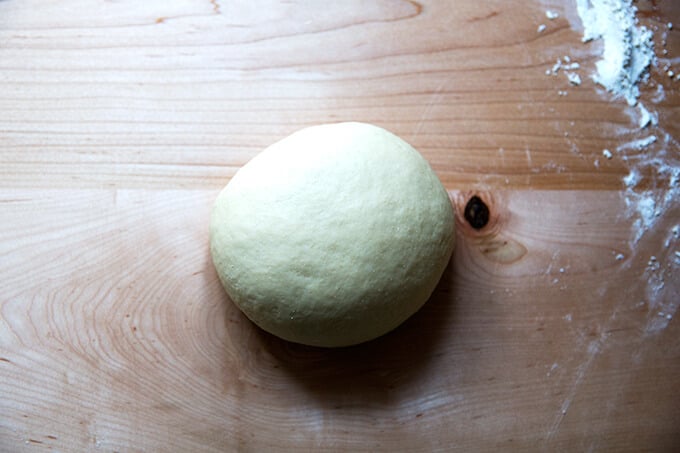
Knead until smooth and elastic.

Let rise until doubled, at least 2 hours.
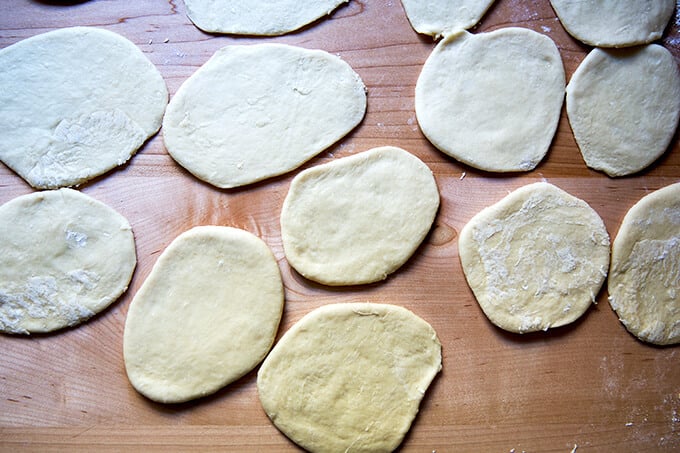
Divide into 12 pieces, then roll each into 4×6-inch ovals.
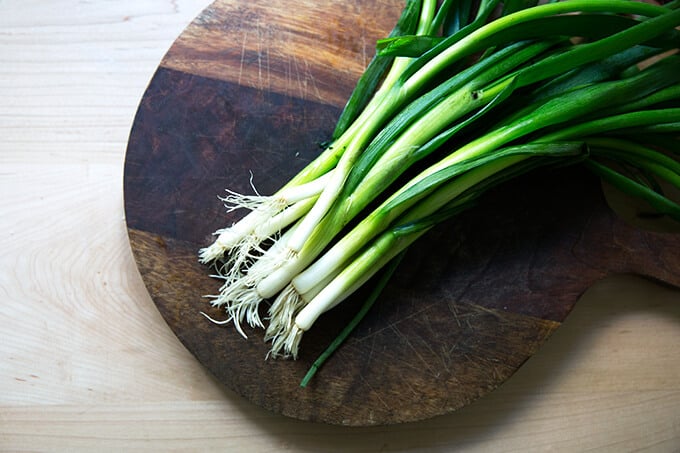
Gather some scallions.
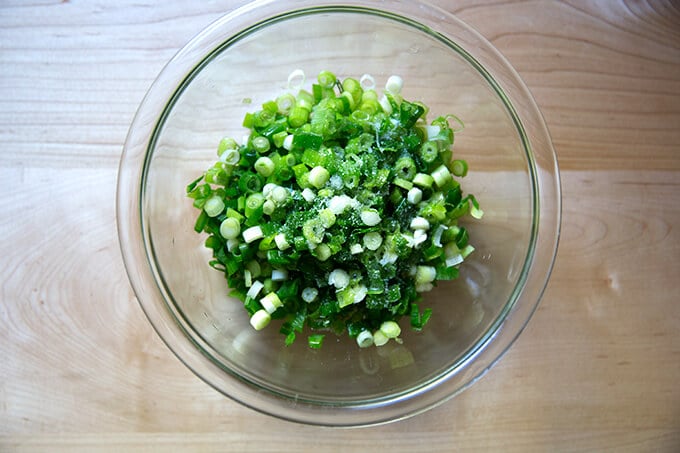
Slice them finely, then mix with oil and salt.
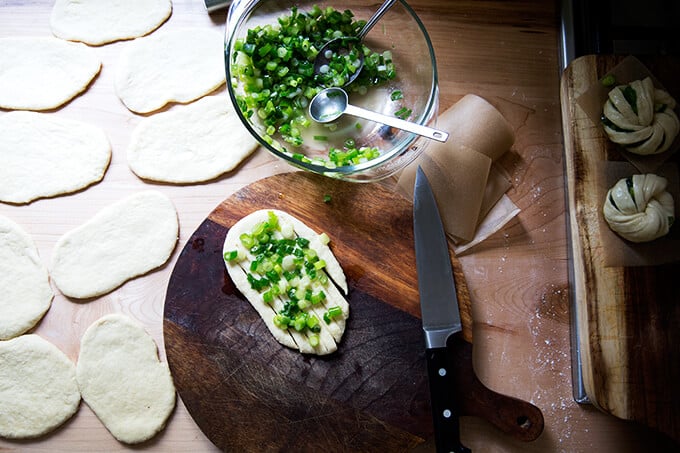
Make slits in the ovals and top with the scallion mixture. Then …

…twist into knots.
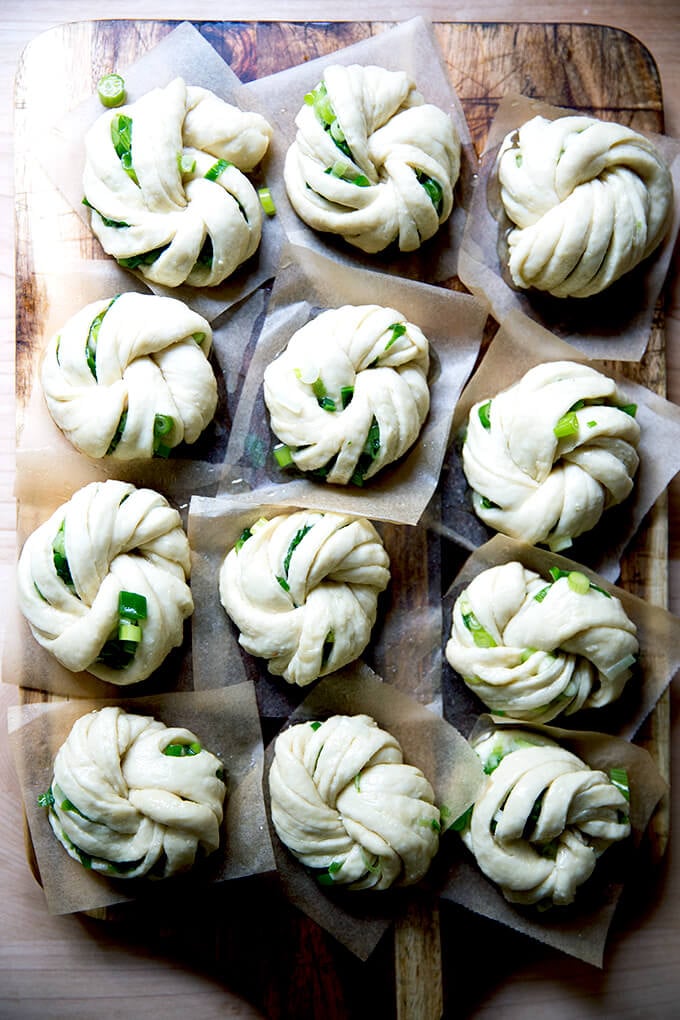
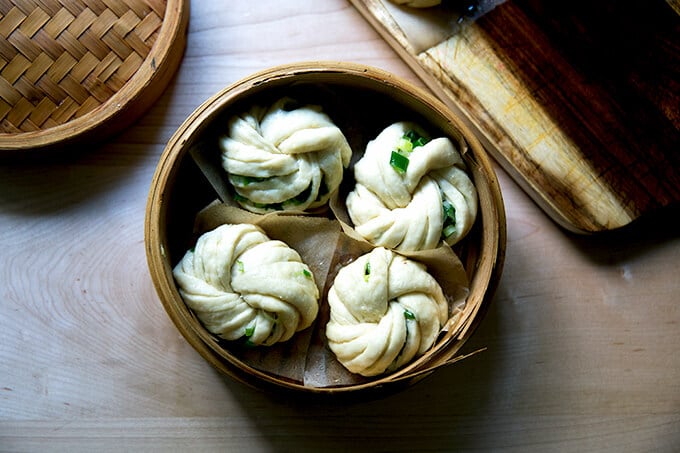
After 30 to 40 minutes of resting, the buns are ready to be steamed.

After 15 minutes in the steamer …
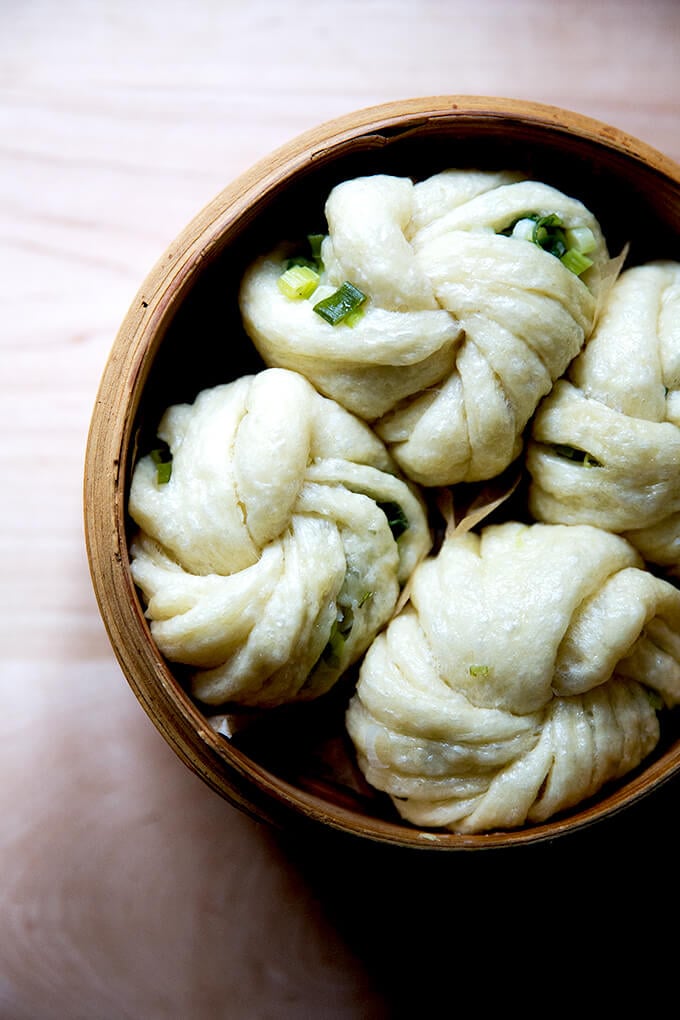

Chinese Steamed Buns with Scallions (Hua Juan)
- Total Time: 3 hours 15 minutes
- Yield: 12 buns
Description
From Cynthia Chen McTernan’s A Common Table
As always, a digital scale is recommended when measuring flour for bread.
This is really nice with Okonomiyaki (Cabbage Pancakes), and it would wonderful aside Red-Cooked Pork Belly and Simple Cucumber Salad as well.
Ingredients
for the dough:
- 1 cup milk
- 1 tablespoon oil
- 3 cups (375 g) all-purpose flour, plus more for kneading
- 2 teaspoons instant yeast
- 1/4 cup sugar
- 1/2 teaspoon salt
- 1 tablespoon nonfat dry milk powder (optional)
for the buns:
- 1 cup finely sliced scallions, from 8 to 10
- 1/4 cup oil
- 1/4 teaspoon salt
for serving:
- sea salt, optional
- soy dipping sauce, I like this one, optional
Instructions
- In a small saucepan over medium heat, bring the milk to a gentle boil. Remove pan from heat. Let cool till 100ºF to 110ºF. Stir in the oil.
- In a large bowl, whisk together the flour, yeast, sugar, milk powder (if using), and salt. Add the milk-oil mixture to the flour bowl, and stir to form a dough ball.
- Turn the dough out onto a lightly floured work surface and knead until smooth and elastic, about 6 to 8 minutes. Return dough to bowl and let rise in a warm spot for at least 2 hours or as as long as 24 in the refrigerator.
- In a small bowl, stir together the scallions, oil, and salt. Cut out twelve 6-inch square pieces of parchment paper. Lightly flour a work surface.
- Turn dough out onto prepared work surface. Punch down to deflate. Using a knife or bench scraper, divide the dough into 12 pieces and shape each roughly into a ball. Using a rolling pin, roll each into a 4×6-inch oval. Working with one oval at a time, slice ribbons lengthwise into the oval, leaving about 1/2 inch at the top of the oval intact—video guidance for this cutting/shaping process can be found here; skip ahead to frames 14-16 for shaping guidance. Brush or spoon about 1 tablespoon of the scallion mixture across the dough. Pick up each end of the oval, gently pull outward, then twist into a coil. Then, twist the coil into a knot. Place the knot on a sheet of parchment paper. Repeat process with remaining ovals until all 12 knots are shaped. Let rest 30-40 minutes.
- Prepare a steamer basket. If using a wok with a bamboo insert, bring 2 inches of water to a boil, being sure water does not touch the bottom of the steamer basket. If using a pot with steamer insert, fill with water, again being sure water does not touch the bottom of the steamer basket, and bring to a boil.
- Place 3 to 4 scallion knots with parchment paper into steamer. Cover. Reduce heat so that water is just simmering. Steam for 15 minutes.
- Serve warm sprinkled with sea salt, if you wish, or a soy dipping sauce.
- Leftovers can be frozen and reheated in a steamer or microwave (about 15 seconds).
- Prep Time: 3 hours
- Cook Time: 15 minutes
- Category: Bread
- Method: Steamed
- Cuisine: Chinese
This post may contain affiliate links. Please read my disclosure policy.












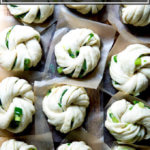
35 Comments on “Chinese Steamed Buns with Scallions (Hua Juan)”
My jaw dropped when I saw these!! Amazing! I’m going to check out the book, too!!!
Thanks, Rosa! The book is BEAUTIFUL!!
These look absolutely incredible!
Rebecca | http://www.peppermintdolly.com
Thanks, Rebecca!!
They look amazing! Can I make them with cashew mil or coconut milk? No dairy for me ☹️
Thanks!
Yes, absolutely! I think water would work just fine, too.
Wouldn’t it be simpler to cut the slits without reaching all the way to the end? That’s how I always have seen them made in China (and how I make them).
Hi James! That is smart! I’m realizing I probably did it wrong—I left 1/2 an inch intact on one end, but cut all the way through the other end … will make a note. Thanks!
Yikes, the instagram video loops at your whisking the flour (frankly we dont need to see that anyway.). In fact,I find it slightly insulting that you think your readers need or want to watch you measure or whisk. Just the knot twist thanks.
Hmm, that shouldn’t be happening — the whole story should be available in the link, and you should be able to skip ahead with the arrows to the shaping part. I don’t know how to link to just the shaping part of the video, otherwise I would have done that. Also, the feedback I have received thus far from many people is that they really, really appreciate the step-by-step video guidance. Sorry you find this insulting.
I’m having the same trouble with the video. It just keeps showing you whisking the flour.
oh bummer, ok, i’m going to delete it. I’ll have to re-shoot this one soon.
That isn’t very nice. This lovely human is sharing skills that maybe not everyone knows. If it is insulting to you to watch someone whisk stuff don’t watch it.
Thank you so much, Jamie 😍😍😍 I so appreciate this 💕💕💕
Ali, you shouldn’t have any trouble making the pork steamed buns. I made delicious ones on my first try over 30 years ago.
These look fabulous but what kind of oil should be used with the scallions?
I use grapeseed oil bc the recipe called for neutral oil, but I imagine a splash of sesame oil in the mix would be delicious, too.
Would you recommend steaming and then freezing to save, or freezing before the steaming step and steaming from frozen for leftovers? Just steaming my first few and hope they are as delicious as they look!
Oh Meagan, I’m far too late here! What did you end up doing? I would generally advise freezing after they’ve been steamed, but I’ve recently been experimenting with freezing dough after the first rise, which works. So you definitely could shape the buns and freeze them; then thaw at room temperature or in the fridge until you are ready to steam.
Beautiful! I just saw the video and enjoyed watching how you rolled one up along each end, knotted and then flipped it over. I will definitely give this recipe a try. Thank you so much for sharing!
Wonderful to hear this!
Thank you for sharing this wonderful recipe! We loved it!
I’m so happy to hear this, Jenn!
Looks great, but curious if there’s any reason you cook the milk other than to warm up to accommodate the yeast?
Hi Wendy! It’s simply to warm it up to accommodate the yeast.
Hi Alex, I’ve been making this recipe for 2 years now and made some modifications for bread machine that might be helpful to your readers:
1) I activate the yeast with warm (100C water) and sugar before adding to mixture.
2) 3min after starting the dough function in bread machine, I test the dough texture with a finger to see if it needs more flour or milk.
3) For best results, I overproof the dough in the machine and then proof the buns a second time in the steamer on low for about 15min.
4) I roll the buns into cinnamon buns then cut them to save time.
5) To prevent the buns from sticking to steamer, I line the steamer with wax paper and poke a lot of holes with a pair is scissors to allow the steam to come through.
Wow, Sophia, amazing! Thank you so much for taking the time to write all of this out and share. So great to hear all of this and so helpful, too.
Thank you.
I’ll admit, I was hesitant to try this one because I have dabbled in steamed Chinese buns. I love all your other bread recipes–especially your soft sandwich loaf in BTC, naan, and light brioche. But I’ve been feeling a bit nostalgic, being Chinese and having lost my mom last year, and craving certain foods.
These buns were delicious! The dough was very tender and light. For the scallions, I replaced some of the oil with scallion oil, added a scant 1/2 tsp of five spice powder, and I was much more liberal with the salt. I am terrible at shaping the little wreaths, but I’m sure I’ll improve because I intend to keep making these (they are a bit time consuming when rolling and shaping).
I’m so glad I stumbled upon your blog last year. I’ve been slowly making my way through all of them. Every single one is a winner–your instructions are crystal clear and never complicated, various suggestions for timing and substitutions, and letting ingredients shine. Thank you for sharing your recipes and stories.
Oops, I have NOT dabbled in Chinese buns!
So nice to hear this, Anna! I can totally see being more liberal with the salt … I am much more liberal now with salt when I create new recipes and when I revisit old ones. I have been meaning to make a video of these buns because I love them so, and I think the process is just so cool, and it’s hard to find a good steamed bun in my neck of the woods. Soon!
Thank you for your kind words and thank you for writing 🙂
Can’t stop making these. I freeze a bunch to have on hand for my toddler!
If I do an overnight rise, should I let the dough come back to room temperature before deflating, rolling, and shaping?
Thank you in advance!
Hi Ling! So great to hear this. And apologies for the delay here. No need to bring the dough to room temperature first — as you delflate, roll, shape, etc, the dough will acclimate to room temperature. Now I’m craving steamed buns!!
I’ve made these twice and they are delicious! Can this bun recipe be used for making the closed steamed bun with filling version? I have some leftover pulled pork I need to use and it would make a great bbq pork bun.
Hi Robin! I would imagine they could, but I’ve never tried so I don’t know how to advise. The flavor of the bun is definitely the same.